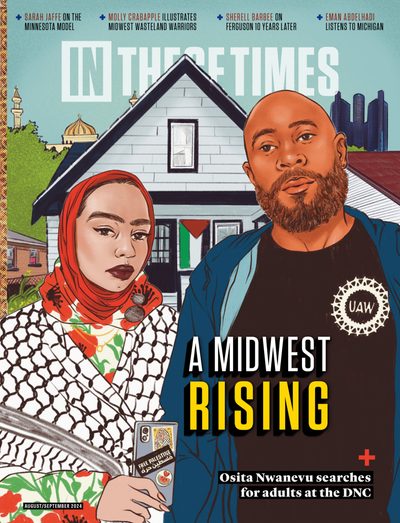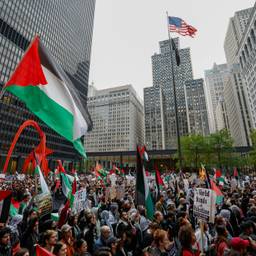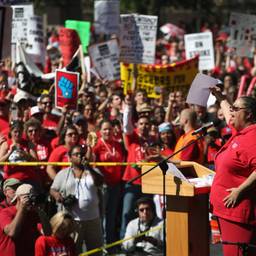As All Eyes Are on Chicago This Week, Don't Forget What This City is About
A pivotal teachers’ strike, decades of movement building, and a surprising mayoral victory: Chicago organizers built a mass movement that has transformed the city. A roundtable with Alex Han, Katelyn Johnson, Asha Ransby-Sporn, Jesse Sharkey, Tania Unzueta and J. Patrick Patterson.
J. Patrick Patterson
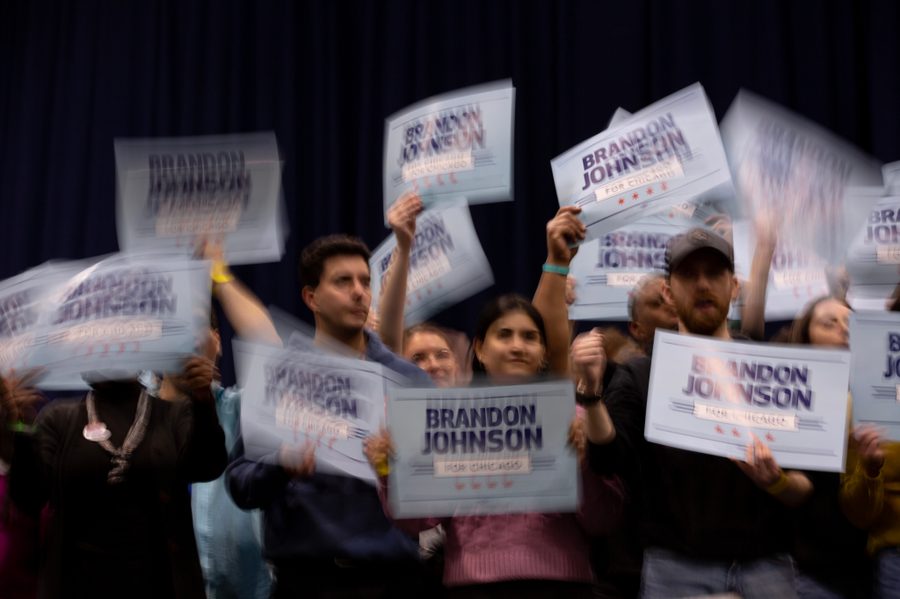
Chicago: the biggest city in the Midwest, hub for industrial unionism and also nursery for neoliberalism (through the Chicago school of economics). From this contradiction has emerged — most recently, in the dozen years since the landmark Chicago teacher’s strike — a rising tide of movement power.
In 2023, Brandon Johnson, a former teachers union organizer backed by United Working Families (UFW), unexpectedly beat former Chicago Public Schools CEO Paul Vallas to take the mayor’s office.
Sign up for our special daily newsletter during the DNC in collaboration with The Real News Network. We’ll be providing on-the-ground coverage and analysis corporate media won’t show you.
Now, Chicago movements find themselves treading new ground as they work with a mayor they helped elect. They’ve pushed alongside him, as with the Treatment Not Trauma campaign to create non-police responses to mental health crises and reopen shuttered mental health clinics. But they’ve also found themselves at odds, as when an unprecedented number of migrants were bused in from red states and Johnson nearly hired a global security contractor to house them.
In March, Bring Chicago Home — a ballot initiative to tax the real estate industry and pay for the homelessness crisis — failed at the polls, serving as a continued reminder that, despite large progressive gains, change is often found on a razor’s edge.
In mid-July, In These Times convened a group of longtime Chicago organizers to discuss where Chicago finds itself, including Katelyn Johnson (BlackRoots Alliance executive director); Asha Ransby-Sporn (a community organizer who helped lead Bring Chicago Home); Alex Han (In These Times executive director); Jesse Sharkey (an educator and former Chicago Teachers Union [CTU] president); and Tania Unzueta (Mijente political director).
This conversation has been edited for length and clarity.
J. PATRICK PATTERSON: Can you talk about your personal history with organizing in Chicago?
ASHA RANSBY-SPORN: I grew up in a movement family in Chicago. I graduated high school in 2012, and we were watching the Chicago Teachers Union prepare for a historic strike. That was in the background. My entry into activism and political consciousness was Chicago’s youth arts programming community — poetry, arts, spoken word. We were making sense of our experiences of race and class and difference in the education system and the city — telling stories about what it meant to be young and Black in this place.
Through that community, I was invited to this national gathering of Black organizers and activists. George Zimmerman was acquitted in the Trayvon Martin case, and we organized a big protest in downtown Chicago that evening. Out of that grew an organization that shaped my political life: Black Youth Project 100 (BYP100). I was 19. I think it’s significant that this movement took off under our first Black president. I was part of a wave of young Black folks — national but really anchored in Chicago — making sense of our generation’s political understanding of Black liberation. We were trying to push past representation and understand the role of state violence in our communities and how it masks and contributes to social problems.
Through various campaigns over the years, the movement shaped me. Playing a role [as South Side field director] in the campaign to elect Brandon Johnson was an important step in the movement coming together, after many years of struggle, to think about what it looks like to work together on solutions.
JESSE SHARKEY: I’m a member of the Chicago Teachers Union and former union president. I organized with the steelworkers union when I was young, and I was active in socialist politics when I moved to Chicago in 1998. But Chicago really transformed my understanding of the importance of labor organizing and having a left-wing vision. I was teaching at Chicago Vocational on the South Side. It was a [majority] Black school, and our schools were really being savaged by budget cuts, systematic underfunding, divestment.
The CEO at the time — he was a CEO, not a superintendent — was Paul Vallas, who became Johnson’s opponent. So we saw the advent of school closings for so-called low performance. Of course, those schools were always in the poorest neighborhoods, overwhelmingly Black and Latino neighborhoods.
Our union was a business union. It did not have answers to these broad social changes that were happening — the politicization of schools, the attacks on our education system — and so a group of us decided to start organizing inside the union. We worked with community groups opposing school closings.
At some point, we realized we had to take over our union. And we did. We had a big strike in 2012 and led a series of big education justice movements that became very connected to community groups and the broad social justice movement in the city.
Asha, you mentioned CTU having an impact. You should know that BYP100 — and the Black youth movement around prison abolition, police reform, etc. — profoundly impacted a lot of educators. I remember us discussing the need to adopt anti-racist policies and positions. And the fact that teachers’ students were making these demands just made it impossible to ignore.
TANIA UNZUETA: I came into the movement through my parents. When we first came to Chicago from Mexico, I was 10 years old, and my parents were already doing a lot of organizing and activism. I remember the marches in the early and mid-1990s.
I was in high school when Arne Duncan became CEO of Chicago Public Schools [in 2001]. He was doing stuff that he’d end up doing later as Secretary of Education. I remember when they put the first metal detectors up. Some of my first organizing was with a group that did anti-standardized testing work in the city.
At some point, my organizing really started getting much more personal. My family and I came to the United States undocumented. I was growing up in a lot of the free afterschool programs. At Radio Arte, a local radio station owned by the National Museum of Mexican Art, I met peers who were also growing up undocumented and who I ended up founding the Immigrant Youth Justice League with in 2009. We started organizing around the idea that, as undocumented people, we had the right not only to tell our stories but also define our demands and our movement. In Chicago, we came up with the “Undocumented, Unafraid” banners that I think defined the undocumented youth movement nationally. Now, I work at Mijente, a national organization doing Latinx organizing.
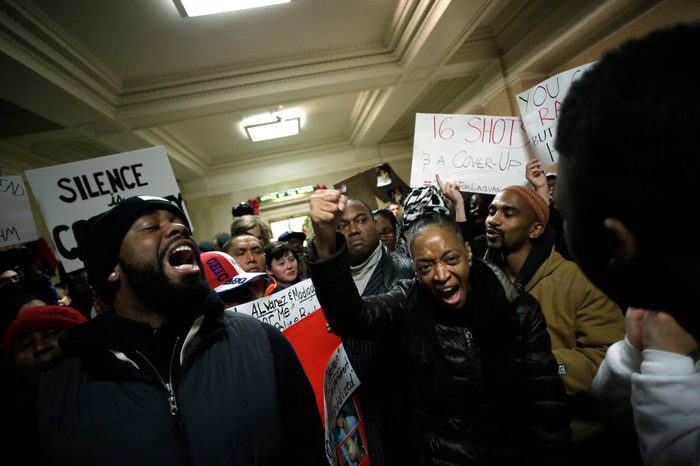
ALEX HAN: I first started organizing in Chicago as a union organizer with what was then SEIU Local 880, now SEIU Healthcare Illinois and Indiana. There was a multiyear fight [from around 1998 to 2005] to stop Walmart from moving into Chicago. Illinois ACORN and the Grassroots Collaborative, a group of labor and community organizations in Chicago, developed a Big Box Living Wage campaign: If Walmart was going to move in, they were going to force it to pay living wages and benefits.
That campaign ended up winning a strong majority vote in City Council but was vetoed by Mayor Daley — the only veto in his 22 years as mayor and the only time he really lost control of City Council.
In 2007, I was living in New York, working on union campaigns around the country, but still paying attention to Chicago. I saw real possibility in Chicago more than anywhere else. In large part, it was the inspiration from the gigantic 2006 May Day mobilization, which was a huge inflection point in years of struggle. And it was watching a movement for police and prison abolition that had huge involvement from Chicago organizing groups. So in 2007, I came back, to then Local 880. And 17 years later, here we are.
KATELYN JOHNSON: I grew up in extremely white rural Pennsylvania, with white supremacists threatening me and chasing me off playgrounds. When I came to Chicago from my small town, I was so excited to meet other Black people who weren’t my cousins. And I thought Chicago would be this utopia, because I saw diversity. But very quickly, I realized the impact of systemic racism in Chicago. I saw it on my campus, North Park University. I learned about organizing through organizing students to respond to racism on campus.
When I graduated in 2004, I got a job with Illinois ACORN. I started as a canvasser around preserving affordable housing on the West Side. Around that time, Illinois ACORN was building the Big Box Living Wage campaign. Mayor Daley was talking about mass privatization of public schools.
Eventually, I got connected with the Chicago Teachers Union. We were running a program called Grow Your Own Teachers, recruiting Black people to join the teaching profession.
Fast forward to 2015, I was working on the Fight for $15. Seeing that become a national campaign was personally meaningful to me because my mom didn’t even make $15 an hour at the time. My organizing journey has led me to where I am today, executive director of BlackRoots Alliance. We’re working to support the safety and liberation of all Black people.
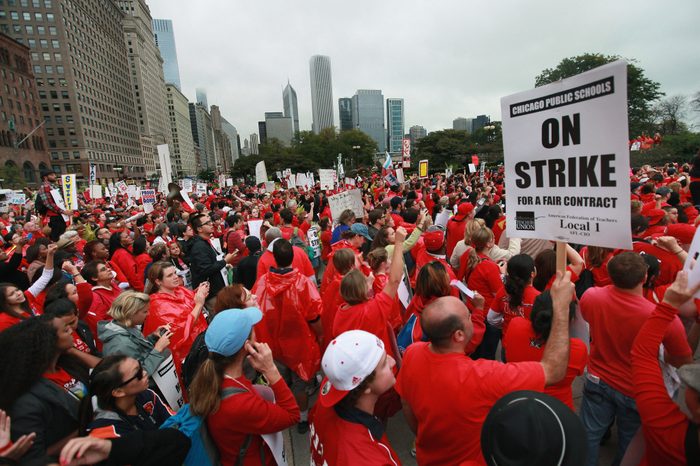
PATTERSON: How do you think about the ways justice movements, labor and progressive politics have changed in Chicago over the past two decades?
UNZUETA: Chicago has always had the opportunity to lead where the federal government has failed, particularly for immigrants. Even though immigration has been defined at the federal level, Chicago has one of the strongest sanctuary city policies, for example.
I think about when Mayor Rahm Emanuel had such a strong hold over government and how frustrating some of those immigration discussions have been. But it’s a completely different playing field now. Chicago’s progressive movement has gotten stronger within government — from Mayor Johnson to a lot of the City Council.
There was a period when there was sort of an expectation that Johnson would just do the things we wanted, while the Right was showing up at City Council meetings every day and applying pressure. There’s a lot of tension here around immigration. The mistake we sometimes make is to let the right wing sort of define what those tensions are. When there was tension between Black and Latino City Council members around migrants, the right wing was trying to make the conversation about that, rather than how we approach the resources our communities need.
I think it’s been difficult for movement to be in government. And I think we need to strengthen our movement infrastructure. We need to focus on base building. It’s really apparent to me — particularly when it comes to immigration issues with the Johnson administration — that there still needs to be a movement outside of City Hall pushing for policies and moving policies to the left.
SHARKEY: One of the things that defined our movement was Rahm Emanuel’s administration. There was something that felt so damn inevitable about the way Daley ran the city. I mean, he was mayor for 22 years, and there were never contested elections. Rahm Emanuel’s style was so aggressive that it produced a unified response from social movement organizations. It provoked the teachers’ strike in 2012. Then he closed 50 schools, mostly in Black neighborhoods. I started to feel like the thing that unites us is that we can campaign against the mayor. And now there’s a mayor that comes out of our social movements, and it means we have to learn some new skills.
JOHNSON: I think back to the teachers’ strike of 2012. It wasn’t just a union over there striking; it was really wielding power in a way that positively impacted our neighborhoods. And I think about the Fight for $15. We pointed out how corporate interests allow CEOs to make millions of dollars while low-wage workers made $8.25 an hour. Finding labor and community allies who could see themselves in each other’s struggles was really important.
HAN: Twenty years ago, it could feel very lonely to be a progressive union in Chicago. And I mean that in the most literal sense. When I was at [SEIU] Local 880, we didn’t always have a lot of allies in the labor movement. They were in community groups like Illinois ACORN and the Grassroots Collaborative and in formations like the Illinois Coalition for Immigrant and Refugee Rights, People’s Action and the People’s Lobby.
The elections of Karen Lewis and Jesse Sharkey to CTU leadership and the creation of the Caucus of Rank-and-File Educators in late 2010 marked a gigantic shift. More recently, we’ve seen the emergence of SEIU Local 73 and the growth of the labor contingent of United Working Families. The fact that there are multiple unions across different industries willing to challenge entrenched power together is a really meaningful change. I think it’s in part because of this flowering of other movement organizing.
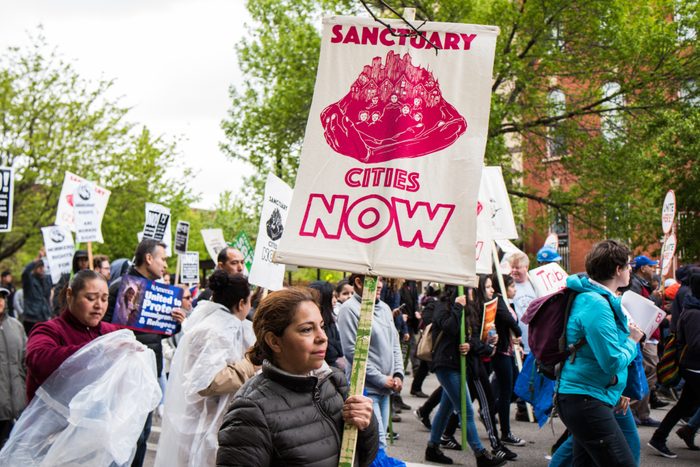
PATTERSON: What are some of the big wins you’ve seen coming out of these movements? For example, Treatment Not Trauma — for which Asha served as campaign field director — made significant progress in fall 2023 when City Council approved a working group for non-police responses to mental health crises.
RANSBY-SPORN: In 2020, you see attention on the police budget and demands to cut it getting popularized. Out of that, Treatment Not Trauma becomes a policy that does a beautiful job of connecting the movement against state violence and the disproportionate impact that violence has on Black people struggling with mental health issues. And it connected those issues with the long-standing campaign to reopen the mental health clinics closed under Rahm Emanuel’s wave of privatization and neoliberal gutting of communities.
So Treatment Not Trauma is really saying we need something other than police officers to respond to people in crisis. We need to really invest in systems of care and public institutions that people rely on. It’s been beautiful to see that organizing move forward.
But part of the demand was that it get funded through cuts to the police department. That did not exactly happen. I think we’re still not in a realm where we can radically shift the budget, particularly [the percentage] that goes to policing.
PATTERSON: Can you talk about some of the big losses, like Bring Chicago Home?
RANSBY-SPORN: The Bring Chicago Home loss was a really big blow. It taught us about our opponents and the power we need to go up against the real estate industry.
SHARKEY: CTU made a cartoon bunny in 2012, like the one for Trix cereal, saying “Silly rich guy, TIFs are for kids,” and we picketed the real estate offices of wealthy developers. TIF is a tax and rent financing program, which sort of operated like a slush fund for real estate developers. Direct confrontation with the rich poses them as the problem and poses us as having the solution. It’s dramatic, it gets on TV and it orients people around a narrative.
And I think that’s some of what we need now. We can’t just send mailers and knock doors to take on the real estate lobby. We’re going to have to identify the ones evicting the most people and start demanding they stop. We need to publicly articulate why they’re the problem and why we have a solution. And frankly, the Right is better at this than us. They demonize us all the time. We should be able to make effective propaganda and build movements.
I agree that losing the referendum on Bring Chicago Home sucked. It showed there’s still a lot of ways we have to develop our forces to get out the word, have our people aligned, conduct campaigns, etc.
The city’s contract with CTU is currently expired, and we’re using public bargaining to amplify a bunch of housing demands: washers and dryers for clean clothes, meals, even places for homeless students to stay, housing assistance. There are 26 CTU members in the field right now door knocking on that and the elected school board. For the elected school board, we’ve endorsed a common set of candidates, and they have a common platform that includes a housing plank. So this is about getting the word out and building out movements. We can’t just say, “Oh, we have a mayor.”
JOHNSON: I see opportunity around reparations. That is a national conversation, but municipalities across the country are popping up with their own responses. We recently had Mayor Johnson issue an executive order around reparations, where he outlined the real estate industry as complicit in redlining. And I think there’s a unique opportunity in Chicago to craft a similar response that allows us to speak to the experience of Black Chicago and challenge the historic disinvestment in Black neighborhoods and inspire people to create a reparations policy that is multi-faceted and includes all the issues impacting Black communities.
HAN: As Jesse said, there was something actually helpful about the existence of Rahm Emanuel, in our ability to campaign against this one guy who represented a lot of what was broken. But we have to be able to affirmatively assert something.
I think about the elected school board as one of those pieces. It is a representation of developing and increasing democracy and connectivity.
But I think that one thing missing is a bigger, overarching demand or vision that can place all of these things so they aren’t a disparate set of slogans and campaigns.
SHARKEY: I sort of think of housing as being at the nexus, partly because of how it’s used as an argument against migrants, as a club to beat immigrants. I’m totally unconvinced that there would have been a so-called migrant crisis in Chicago if the newcomers in the city weren’t unhoused. It was a housing issue at heart. That, in turn, was connected to the fact that the city tore down some 20,000 units of federal housing and never replaced them.
UNZUETA: I think you’re right about housing. I feel like immigration issues haven’t always been seen as part of the progressive agenda, and some of that is on us working on immigrant rights. Under Rahm Emanuel, for a long time, part of the immigrant rights movement was very integrationist. Like, let’s build an Office of New Americans, and that’s our contribution.
It wasn’t until, say, 2016 — in great part because of CTU’s push against Emanuel — that we saw an opportunity to really create a movement that was pushing City Council and the mayor toward more progressive ideas.
When it comes to the Johnson administration and the migrant crisis, there are definitely places to push and places the mayor could be doing a lot better and listening to immigrant rights organizations.
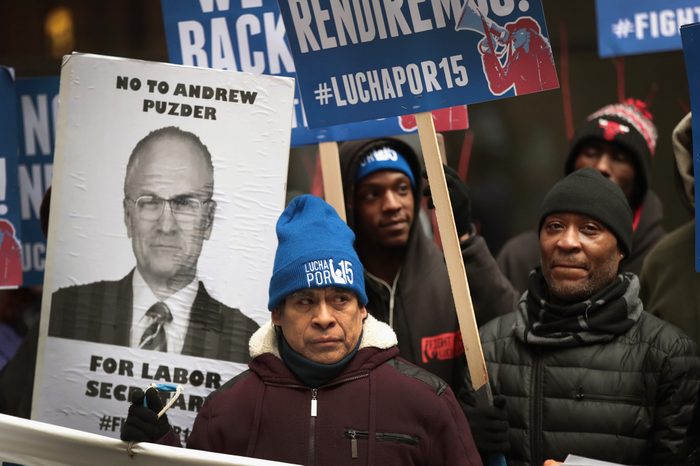
At the same time, we’re in a place where the Democratic Party doesn’t have the politics to actually fight for immigrants and undocumented people. Like a lot of social issues, they’re very much on the defensive. While the Republican Party is saying, “mass deportations,” a Democratic administration is closing the border.
I have a lot of hope for the movement in Chicago, both inside the administration and outside, to come up with better solutions. We also need a little bit of room to congratulate ourselves because despite the national context, and despite our unhappiness with some details of local politics, we are really well positioned to push the conversation to the left, even within the Democratic Party.
We also need more base building. The opposition has money and the ability to place ads. Our strength is movement and mass and base. And we have done better. There was the fight to increase the minimum wage and the success it had in City Council. We not only need to better communicate our agenda but also figure out how to include some populist stuff in there that working-class people, everyday people, also want to fight for.
PATTERSON: Where do Chicago movements go from here?
SHARKEY: We need independent movements. We need clear, ruling-class targets. Our movements have to take positions that are critical of our brethren in office, and frankly, our union brethren in office. Johnson is sometimes going to be forced, for political reasons, to take positions that are uncomfortable for us. And actually we don’t have to have mortal combat to have disagreements.
In some cases, it’s not governing power we need, it’s class power. It’s how to expropriate wealth that was unfairly gained and redistribute it in working-class communities of color. It strikes me as hard to mobilize movements that can shake up the system unless they are independent mass movements with class demands.
UNZUETA: I think we can push a better understanding of immigration. It’s getting defined as a social service [issue]. But there’s also a need to understand immigration as a global and labor [issue] — as corporations push people out, they come here. Once people understand that the corporations giving us low wages and advocating for our housing to close down are the same ones causing migrants to need to come here, there will be better understanding of what we need to change.
Chicago plays an important role in the national context and in how other mayors react. I think we’ve been a good leader in showing what’s possible both inside and outside government.
J. Patrick Patterson is the Associate Editor at In These Times. He has previously worked as a politics editor, copy editor, fact-checker and reporter. His writing on economic policies and electoral politics has been published in numerous outlets.
